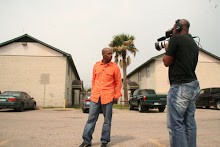

Spiritual Journey Leads to Historic First
Published: June 5, 2009
Forty-five years ago, Alyssa Stanton was born into an African-American, Pentecostal family in Cleveland. On Saturday, Ms. Stanton is to become a rabbi — the first African-American woman to be ordained as a rabbi by a mainstream Jewish seminary, said Jonathan D. Sarna, professor of American Jewish history at Brandeis University.
Ms. Stanton is scheduled to assume the leadership of an overwhelmingly white synagogue in Greenville, N.C., in August. In interviews, many observers drew parallels between her joining the rabbinate and November’s presidential result.
“It is of incredible importance to note that her ordination coincides with the election of Barack Obama,” said Rabbi David Ellenson, president of Hebrew Union College, who will ordain Ms. Stanton at the college’s Cincinnati campus on Saturday. “It offers a ray of hope that the world can become a better place.”
Ms. Stanton and members of her new synagogue, Congregation Bayt Shalom, say they were surprised by the overwhelming national interest in her ordination. To them, her race and sex are footnotes to the more important story of a rabbi and a congregation finding themselves to be a comfortable fit.
“I’m just a little person trying to pay my bills and raise a daughter and help others on their spiritual path,” said Ms. Stanton, a single mother who adopted an infant girl 14 years ago.
The Greenville congregation is small and values diversity as a matter of choice and necessity. It is one of just a handful in the United States that is affiliated with both the Reform and Conservative branches of Judaism. Among its 60 families are “three or four” African-Americans, said Michael Barondes, Bayt Shalom’s president.
“We are a one-synagogue town, so we are trying to be inclusive,” Mr. Barondes said. “Naturally it’s unusual to have an African-American leading a Jewish congregation. But when she came here and spoke from the pulpit, it felt surprisingly natural.”
Ms. Stanton’s transformation from a young Christian seeker into a Jewish spiritual leader spans an era of sometimes difficult change, for herself and for her chosen religion. She grew up in a Jewish neighborhood in Cleveland Heights, Ohio. It was a time when most Jews in the United States were white European immigrants or their descendants, said Rabbi Stephen C. Lerner, director of the Center for Conversion to Judaism in New York. Women were not yet allowed to be rabbis.
“From a very early age,” Ms. Stanton said, “I felt a strong spiritual stirring.”
As a child, she said, she attended a Pentecostal church in Cleveland with her mother. When she was 9, she recalled, she phoned a priest to ask questions about Catholicism.
Later, after her parents divorced and she moved with her mother to Denver, she went on to attend a Baptist church, study Eastern religions and visit a few services with a group of Messianic Christians who practiced Judaism and spoke in tongues.
Although the Reform and Conservative branches of Judaism began ordaining female rabbis in the 1970s and ’80s, many blacks and Jews still believed it was impossible to be both black and Jewish.
When she joined a synagogue in Fort Collins, Colo., Ms. Stanton said, she encountered hostile stares and silence. Later, as a rabbinical student at Hebrew Union, she was first denied a visa to study in Israel, but the Israeli government finally relented. Her daughter, who was 7, was beaten and ostracized by Israeli children in Jerusalem for being black, Ms. Stanton said.
“Most of my Christian friends thought I’d grown horns,” she said. “Many of my African-American friends thought I’d sold out. And the Jewish community was less than welcoming. It still hurts a bit.”
But many people who have gotten to know her said they were impressed by her warmth and intelligence. Several remarked about her deep brown eyes, describing them as simultaneously piercing and comforting.
“I myself suffered from a health problem this year, and Alyssa touched me very deeply with her concern and her genuine compassion,” Rabbi Ellenson said. “There is a genuine depth of soul about Alyssa that will make her congregants quite blessed to be in her presence.”
At Congregation Emanuel in Denver, a Reform synagogue, Ms. Stanton said, she took her first role as a congregation leader. She served as a cantor and impressed the congregation with the strength of her faith, Rabbi Steven Foster said. It was there that she decided to become a rabbi. Studying for the rabbinate normally takes five years, but because of health problems, it took her seven.
“I’m proud of her,” Rabbi Foster said. “And I’m proud that we in this congregation have been so supportive over the years.”
Ms. Stanton said that she has gradually found acceptance as the Jewish community itself has grown more diverse. Today, about 20 percent of Jews in the United States, or some 1.2 million people, are from non-European racial and ethnic backgrounds, including African-Americans and Latinos, according to the Institute for Jewish and Community Research in San Francisco.
“Not long ago, even people in the Jewish community believed that you could tell Jews by how they looked,” said Dr. Sarna of Brandeis. “In just one generation we have moved to a vastly more pluralistic Jewish community in the U.S.”
As she prepared for her ordination, Ms. Stanton said she did not want to be reminded of the ceremony’s historic importance.
“I feel awe and a healthy dose of fear about being the first,” she said. “I try to keep it simple. I am a Jew, and I will die a Jew.”

















No comments:
Post a Comment